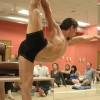He won wearing bright yellow shorts in front of a silent staring audience. He won by putting the arches of his feet flat on the top of his head while holding himself upside down.
Esak Garcia is a jet-setting yogi. He is champion of the 2005 International Yoga Asana Championship, The Bishnu Charan Ghosh Cup, named for the Indian yoga master who spread yoga beyond the sages and holy men starting in the early 1900s until his death in 1970. The Ghosh Cup, is a global yoga competition held in February, where the final four contestants are judged on a three-minute demonstration of seven postures.
He didn’t know at 17-years-old when his mom took him to a yoga class in Boulder that it would become his life.
It wasn’t until after he graduated from Yale with a degree in political science, or after living in Brazil, or after trying to find out what he wanted to do for a career, that Garcia remembered his yoga. It was the thing had that been a consistent part of this life for the longest time.
“I wasn’t really looking for yoga. I was more interested in other things – sports, and education, and work,” said Garcia, now 32, via Skype from Hong Kong. “I just found that practicing yoga contributed so much to my ability to participate in everything else that I was doing.”
Garcia teaches clinics on how to compete in the Ghosh cup all over the world such as Wisconsin, Mexico City, Boulder, British Columbia and in northern California. He also is a dedicated member of a traveling ministry called the Circle of Light. The group is part of the Institute of Ancient Mysteries with a belief system based on attaining self-realization by extending God’s love onto the physical Earth. According to the ministry’s website, part of their mission is to,
“spread the energy of Light & Love to as many corners of Planet Earth as possible”
Institute participants follow a curriculum to master the “advanced mysteries” that includes retreats, global travel and daily practice. The institute’s founder Carolyne “ISIS” Fuqua, is a close friend and mentor of Garcia’s. Garcia and his wife of one year and 2007 Ghosh Cup champion, Chau Kei, along with their 8-month-year-old son are in Hong Kong doing the work of the Institute right now.
Garcia listens to what he hears. He doesn’t rush to answer questions before they are asked. He delivers a full answer. He is calming and invigorating. Just like yoga.
“I found that within Bikram there’s enough, there’s a whole universe there,” Garcia said. “There’s enough to keep me busy my whole life and I’m really interested in that. When I realized that I started to focus more on it and teach it.”
Born and raised in Boulder to a Mexican father and Jewish mother, Garcia still calls it home. When Garcia is not traveling, he lives in Boulder and practices yoga at his mother’s studio, Bikram’s Yoga College of India, off of Valmont Street just before 55th Ave.
Champion of the Ghosh Cup in 2006, Johnny Mauk, is a friend of Garcia and his family.
“He is someone who has always been there to support me, not to coddle me or anything,” Mauk said, standing in red shorts having just taught a Bikram class at Garcia’s mother’s studio. “He’s a light in my life, just a really good friend.”
Garcia’s mentors are leading yoga teachers, Mary Jarvis, and the founder of Bikram, Bikram Choudhury. He studied under Choudhury at the Bikram Yoga College of India in Los Angeles, graduating in 2001 with a certification to teach the Bikram method.
In 2003, the first year that a competitive yoga championship was held in the United States, and after nine years of practicing, Garcia decided he would compete. To train, he spends five to six hours a day on the physical, or hatha, aspect of yoga. He keeps that regiment up for about two months at a time. The rest of his life has to be mellow when he trains. He doesn’t take on other commitments. It can take away from deepening his yoga practice. He says he needs rest, downtime and to go slow.
Garcia eats chicken, fish and dairy. He doesn’t eat red meat. He doesn’t drink alcohol, caffeine, or use any other stimulants. It interferes with his practice.
“Prior to competing, I had never done yoga as a full-time practice. When I started exploring yoga at that depth, I became so sensitive to even a glass of wine,” Garcia said. “It affected me so profoundly that it was just a matter of priority to give it up.”
The tradition of competitive yoga is alive in other parts of the world, especially India, but not as much in the U.S.
“It’s been met with a lot of resistance, or there’s been a mixed reception of it,” said Garcia.
Many people who do yoga have said that it is contradictory to the reasons you practice: self-realization and inner balance. Competition is thought by opponents to be selfish. Around the 2008 summer Olympics a group of leading yogi’s started to push for adding yoga to the Olympics in 2020. Yogasiromani Gopalji, executive director of The World Yoga Council, along with Chandry, Garcia, and other Ghosh Cup competitors are leading the movement.
Balance, strength, flexibility, poise, and grace are judged in yoga competitions. For supporters of competitive yoga and putting it in the Olympics, they want to legitimize the practice not as a sport but as an inspiration for a healthy lifestyle. The Olympic committee is hesitant to add another subjectively judged activity into the games.
Since his win in 2005, Garcia has not been driven to compete again. He still trains as if he were to compete, so that he can lead clinics and train others more completely. Garcia is working to build support for the Olympic yoga movement right now as well.
“Once I won the competition, then stepping out of the competition and not competing but still participating, is a way to give the spotlight to other people to have their experience there,” Garcia said. “My experience there was really profound and life changing.”
The hope of having yoga in the Olympics is that it would make the practice more accessible and legitimate for a lot of non-believers, he said. Garcia wants to expose people to yoga. The way it can sustain energy and the way it can permeate all aspects of life. He wants yoga to reach people.
“Millions or billions of people all over the world that would otherwise think that yoga is a religious cult or something like that. It’s going to make it attractive to youth who are playing football in the United States or hockey in Canada and rugby in other countries,” Garcia said. “These games are so harsh. For youth it’s okay, they’re resilient, but once you get in your 20s, 30s, you can’t play those games anymore.”
The thought is that If kids are exposed to yoga through the Olympics then it will be more likely they will add it to they’re own form of physical cultivation. Garcia is a yogi because it makes him happy. The word yoga means union. It means that everything is one and finding that balance is the core to yoga’s philosophy.
“The hatha part of yoga, I think is a very intelligent art form that deserves respect,” Garcia said. “And not only does it deserve respect but people deserve access to it.”
Sarah Horn is a West-coast raised writer who recently relocated to Boulder for school, snow and new experiences. Interested in issues that help keep our air fresh, our forests flourishing and our bodies healthy.
 Share on bsky
Share on bsky











Read 10 comments and reply